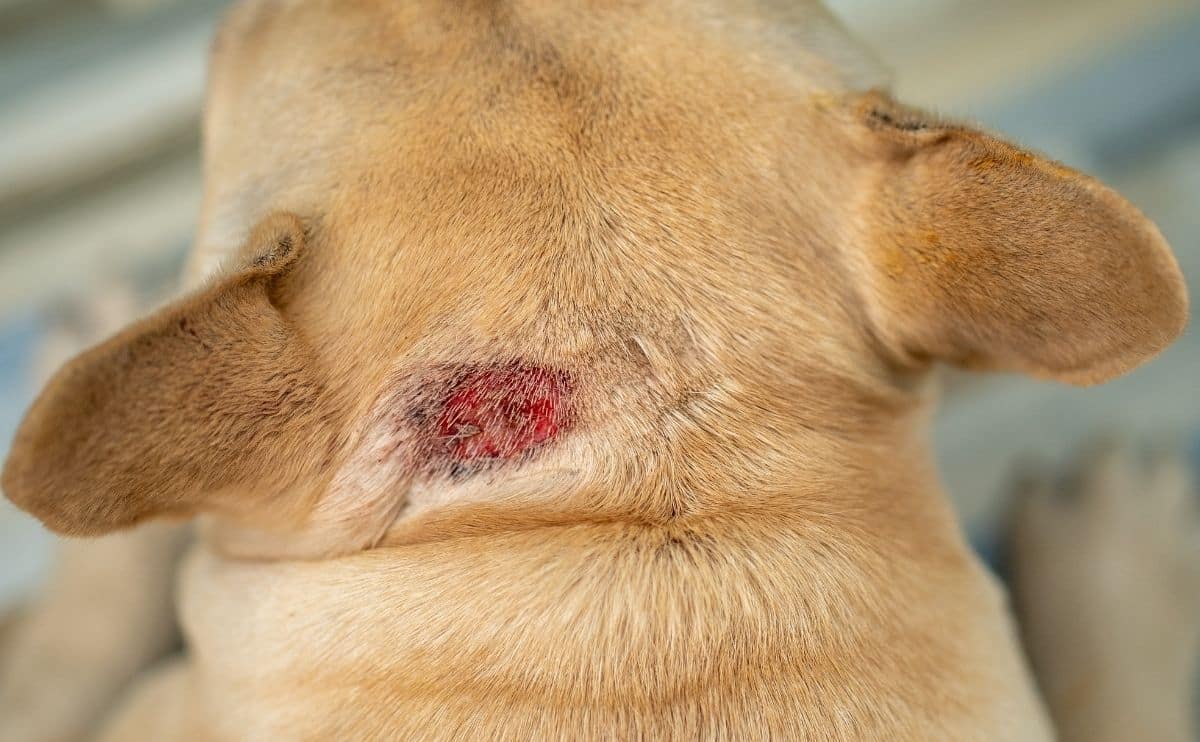What Is Mange In Dogs? Treatment, Home Remedies, What Does It Look Like, How Do They Get It, & More
When you purchase through links on our site, we may earn a commission. Here’s how it works.
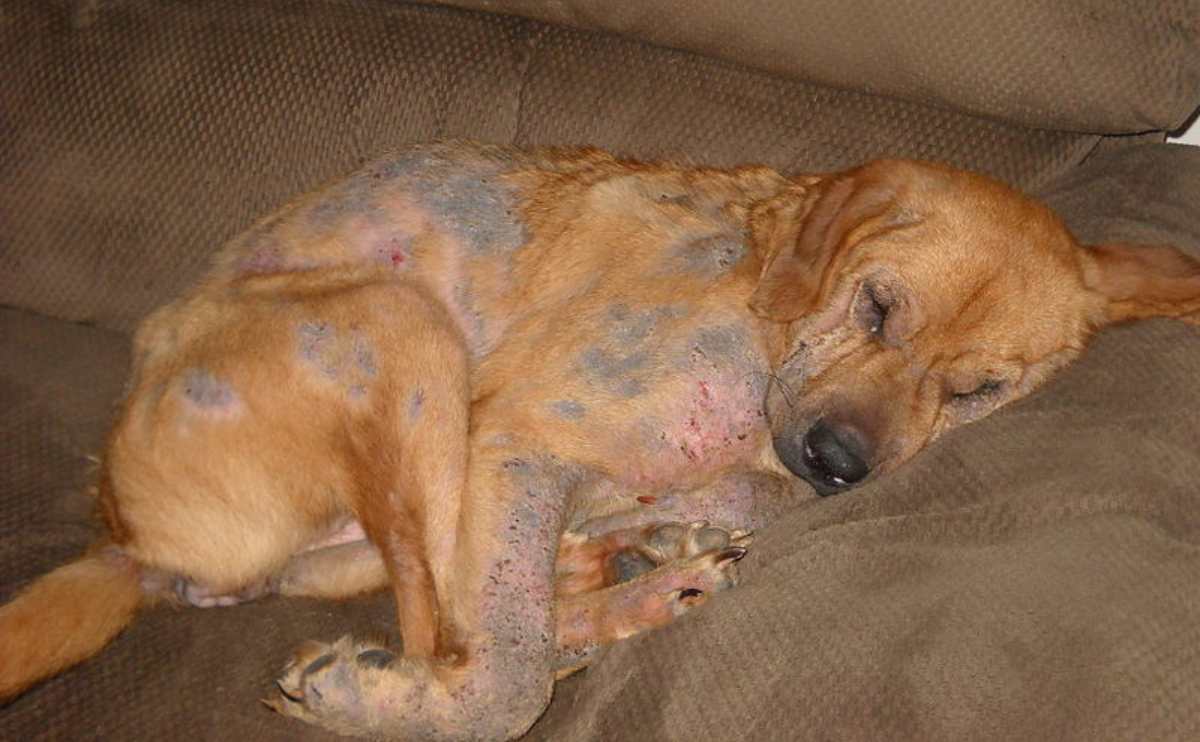
You’ve most likely seen horrific images of animal organizations rescuing mange-ridden dogs. What you may not know is that mange doesn’t just affect neglected animals. This common skin disease can strike any pet. Untreated mange can result in a hairless, sore-covered dog in lots of pain. That’s why it’s essential to treat mange at first sight. Don’t let your dog’s skin turn to stone.
Table of Contents
What Is Mange?
Mange is a skin disease that’s caused by a particularly prolific parasite called a mange mite. These microscopic mites are tiny parasites that burrow just below the surface of the skin and feed on skin cells. There are two types of mange in dogs, demodectic and sarcoptic, each caused by a different mite.
Mange is only one of many skin conditions you may encounter with your pup. Our experts can give you more insight into other skin conditions and skin allergies in dogs.
A Veterinarian’s Experience With Mange In Dogs
Dr. Rebecca MacMillan, BVetMed BSAVA PGCertSAM MRCVS, shares her experiences with treating mange in dogs.
“There are two types of mange in dogs, which are caused by two different types of microscopic mites: demodex and Sarcoptes. Both types of mange have the potential to cause widespread hair loss, skin infections, and itchiness if left untreated. However, the demodex mite can also be found at low levels in healthy dogs without causing issues.”
Dr. MacMillan adds, “In my clinic, we tend to find that demodectic mange is diagnosed more commonly, and it is often caught early, compared to dogs with sarcoptic mange. These dogs, therefore, tend to just have small areas of hair loss, with or without itchiness, when they are treated. Dogs with sarcoptic mange, however, often have widespread itching, crusting, and skin inflammation, which can often be confused with other complaints like skin allergies. I saw a patient like this recently who had a long-standing issue, but we managed to diagnose and treat the problem after taking some samples. Patients with sarcoptic mange often appear to be worse than those with demodex at the time of diagnosis, but both conditions may cause similar problems if left unchecked.”
“If you think that your pet is at risk from mange, the best treatment for them is one that has been prescribed by your vet. There are different prescription spot-on products and tablets that are effective at preventing your pet from catching mange or treating a current infection. I have treated both sarcoptic and demodectic mange successfully with these types of products and recommend them above over-the-counter products or home remedies.” Dr. Rebecca MacMillan.
“So, if you are thinking about adopting a dog that has mange, then I would strongly recommend that you see your vet for a regularly administered preventative product for your existing pets. You should also routinely hot wash their bedding and keep an eye out for any symptoms,” explains Dr. MacMillan.
What Does Mange Look Like On A Dog?
You may be wondering what mange looks like on a dog. There are some additional pictures below of the two types of mange. These give you a general idea of what you might see if your dog gets mange. However, nothing substitutes for an official diagnosis from your vet.
Types Of Mange In Dogs
The two types of commonly diagnosed mange, demodex and sarcoptic, are similar but have some noticeable differences.
Demodectic Mange
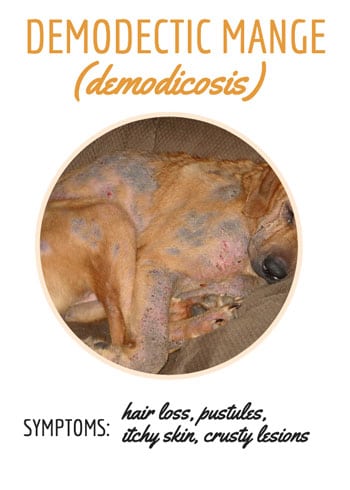
Demodectic mange, also known as red mange, demodicosis, or demodex, is caused by a commonly occurring, cigar-shaped mite called Demodex canis. This mite usually inhabits every dog’s skin and lives in the hair follicles. Problems arise when these mites overpopulate due to the dog’s immune system being unable to keep the mites under control. Red mange refers to the red, irritated skin the mites cause.
Dogs with weakened immune systems are especially susceptible to demodectic mange.
Dogs suffering from demodectic mange either have localized areas of the disease or their entire body becomes infected, a condition called generalized demodectic mange. Secondary skin infections can develop, complicating the healing and treatment process. The good news with this form of mange is that demodectic mange is not contagious.
Symptoms
- Hair loss
- Pustules (small skin bumps that contain pus or fluid)
- Itchy skin
- Redness and welts
- Crusty lesions
- Secondary skin infections
- Thickening and darkening of the skin
If your dog has demodectic mange, you may be interested in this article about essential oils for dogs. The article also includes other ways to treat common ailments for dogs, like fleas, allergies, anxiety, and more.
Sarcoptic Mange
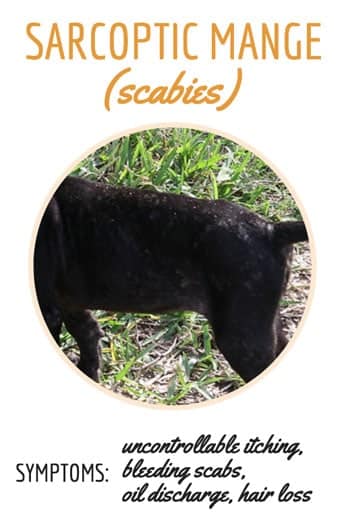
Sarcoptic mange, or scabies, is caused by the parasitic mite Sarcoptes scabiei. It often begins in one area of the body and can cover the entire body if left untreated.
Symptoms usually appear anywhere from two to six weeks after exposure. Locations such as kennels, vet clinics, groomers, dog parks, and shelters are prime places for dogs to get infected with scabies.
Symptoms
- Uncontrollable, intense itching
- Skin lesions may appear as thick crusts, bleeding scabs, or even oily discharge
- Hair loss
- Skin rash
- Dandruff
- Small bumps on the skin
Warning: You can Get Scabies From Your Dog
Owners often complain of itchiness after a vet determines that their dog has scabies. Remember, you CAN catch scabies from your dog. Scabies are highly contagious among dogs and can also spread to humans and other animals.
How Do Dogs Get Mange?
Demodectic mange occurs when naturally present Demodex canis mites overpopulate. This can happen when the immune system is weak, usually from another illness or infection or hormone fluctuations, and cannot keep the mite population at bay.
Sarcoptic mange is contagious, and dogs can get infected by contact with another dog or animal with mange. Sarcoptic mange can also spread by exposure to contaminated bedding.
Early-Stage Mange In Dogs
Ideally, you can catch the onset of mange when it’s in the early stages. That’s the best way to prevent your pup from dealing with the symptoms of mange long term. Symptoms of scabies can begin to appear anytime from 10 days to 8 weeks after exposure, while the symptomatic onset of demodectic mange is not as predictable because it can occur at any time. However, if you know your pup has a weak immune system, you’ll want to keep an eye on him.
Early signs include itching and redness at the margins of the ears, chest, elbows, hocks (animal version of human ankles), and belly.
Diagnosis
If you suspect that your dog has mange, your vet will take skin scrapings and look at them under a microscope to diagnose demodectic mange or scabies. Mites are too tiny to see with the naked eye. Also, sarcoptic mange mites like to burrow deep into the skin, making them even harder to see.
Keep in mind that there are many false-negative results with scabies, meaning that the skin scraping doesn’t show any mites despite a dog’s symptoms indicating a scabies infection. Often, this diagnosis involves excluding other possible diseases or a therapeutic trial of medication.
Handling The Cost Of Care
Getting a diagnosis and paying for the cost of treating your pup for any illness can be costly. To help curb care expenses over your pet’s lifetime, it’s best to consider pet insurance from the start. If your dog has a health concern before insurance coverage begins, his medical expenses may be regarded as a pre-existing condition and may not be covered.
Mange Treatment In Dogs
Treatment for mange varies depending on the type. However, treatment is typically very successful and carries a good prognosis. A licensed veterinarian should always oversee treatment to ensure proper care and the best outcome possible.
Treating Demodectic Mange
- The underlying cause of the weakened immune system must be addressed
- In localized cases, it usually resolves itself but may given treatment with a topical medication
- For generalized cases, a dog might need long-term oral and topical medication
- In some cases, veterinarians may choose an injectable medication, doramectin, to treat demodectic mange
- Your vet may prescribe a daily dose of Ivermectin (often used to prevent heartworms) until the infection clears up
- Secondary skin infections may need treatment through antibiotics and shampoo therapy
- Spaying females can help reduce hormone fluctuation, which can cause the disease to occur
- Feeding your dog high-quality food and preventing stress can help reduce flare-ups
Treating Sarcoptic Mange
- Your vet will likely prescribe an oral or topical medication to kill the Sarcoptes scabiei mites
- Ongoing treatment will be necessary because eggs take time to hatch
- In some cases, you can use a medicated shampoo to relieve your dog’s skin condition
- Medicated dips containing amitraz (an insecticide) and lime-sulfur are sometimes prescribed by veterinarians to treat scabies (amitraz cannot be purchased without a prescription)
- Because of the contagious nature of this type of mange, you’ll need to clean thoroughly any areas where your dog has been
What Is The Best Home Remedy For Dog Mange?
How to treat a dog for mange at home depends on the specific situation and how far the condition has progressed. Reaching out to the vet before trying any home treatment is the best to ensure the most complete recovery. If you think your dog has mange, schedule an appointment with your vet to get an official diagnosis. The last thing you want is to assume that your dog has one illness when, really, it’s something else.
Once you get a confirmed diagnosis, talk to your vet about possible home remedies, such as:
- Brush the fur to help remove scaly skin and scabs (check out these brushes)
- Apply two tablespoons of plain yogurt that contains acidophilus to the ear where affected (this isn’t good to use in other affected areas of the body because the dog will most likely lick it off)
- Add one tablespoon of apple cider vinegar to your dog’s food
- Put two drops of cooking oil on your dog’s infected skin
- Slice one lemon (keep the peel on) and add it to boiling water. Let it sit overnight, and apply the mixture to your dog’s coat using a sponge.
- Wash your dog with warm, soapy water
- Clean your dog’s bedding and other places where he sleeps to prevent the spread of mange
Keep in mind that the home remedies listed above target only mange mites that are on the skin’s surface. Your vet can help you decide which home remedy, if any, may be appropriate for your dog.
If the mange is severe, your vet will advise you to skip a home remedy and instead recommend a prescription or other course of treatment.
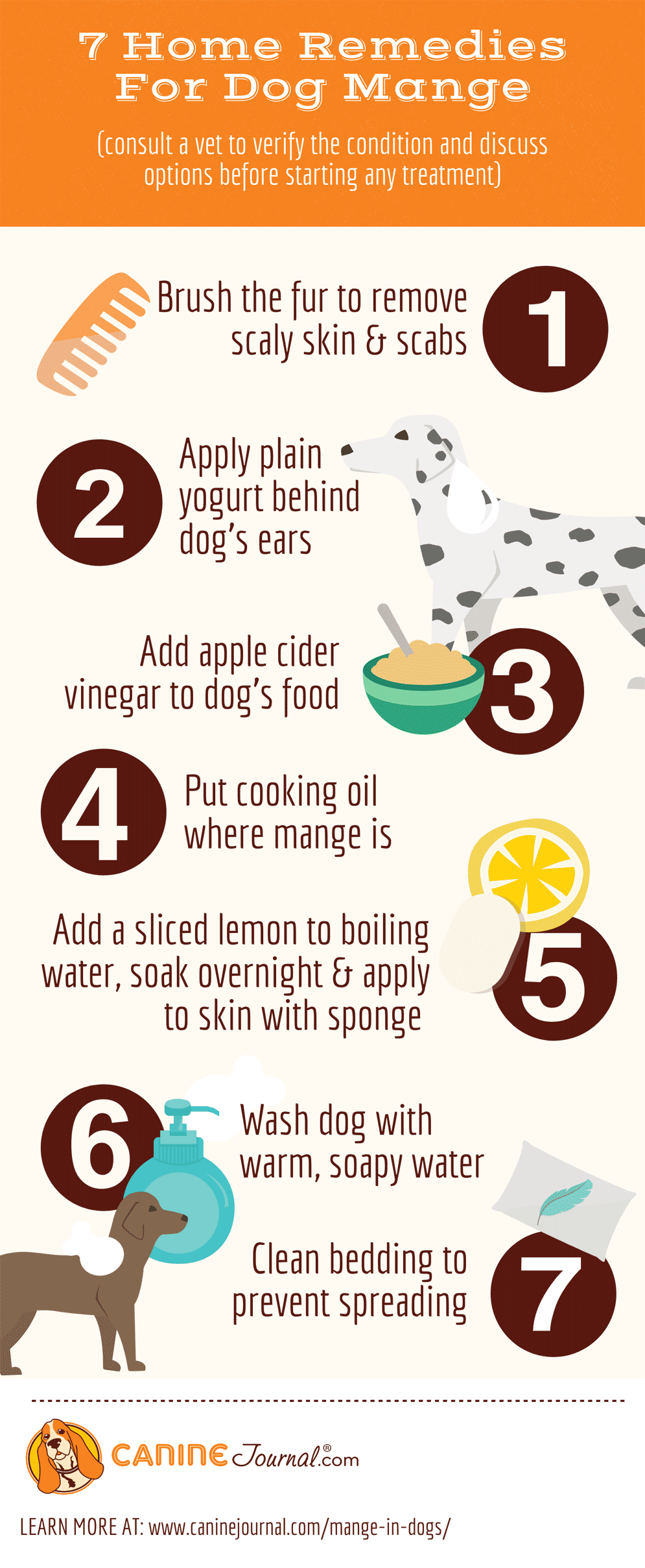
What To Expect When Treating Mange (Video)
In this two-minute video from Rated Red, Dr. Matt from Vet Ranch talks about mange and how to treat it.
Common Misconceptions About Mange
There are several misconceptions about mange. Below, we clear up a few of the biggest mange myths.
- Misconception – Scabies come from being dirty. This is false. Scabies are not a result of being dirty or having poor hygiene.
- Misconception – Mange is just allergies. False again. Mange is not a result of allergies, though it can present some of the same symptoms.
- Misconception – Motor oil can treat a mange infection. This is totally false. Never try to treat mange by putting motor oil on your dog. It will not kill the mites and can cause sickness and severe skin reactions.
Did you know that ear mites can also cause a form of mange? The Otodectes cynotis mites can infest the ear canal and cause otodectic mange. The condition causes itching, inflammation, pain, and hair loss.
Has your pup been affected by mange? Please share your experience treating mange with us in the comments.
Consider CBD Oil For Mange Relief
The symptoms of mange can leave your pup itchy and frustrated. Learning about the benefits of CBD oil could be a way to calm the skin irritation your dog has from mange. Once you discuss this option with your vet, you can read our expert reviews of the best CBD oil and CBD treats. Lots of the companies we review offer topical CBD ointments that may be a good choice for your furry friend.



